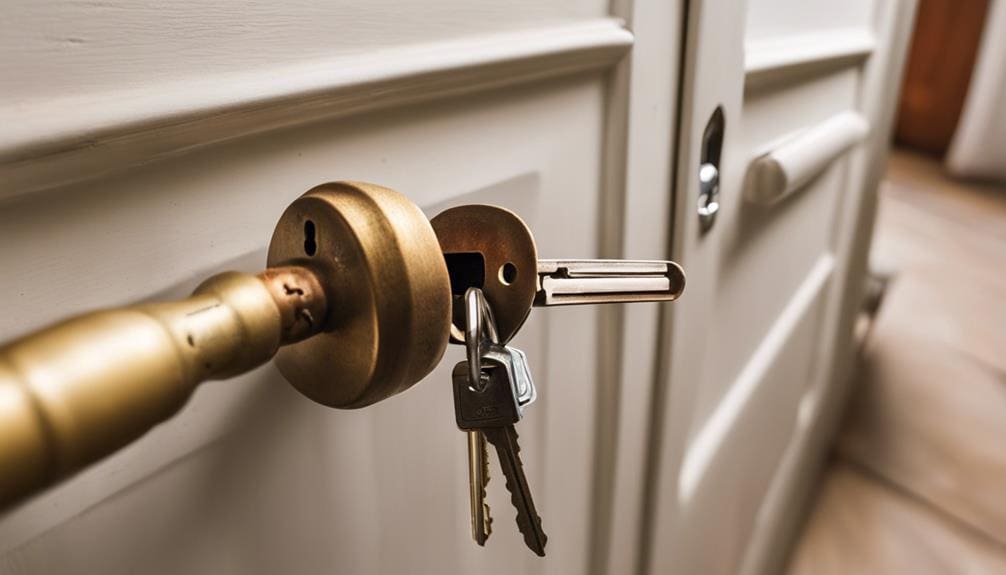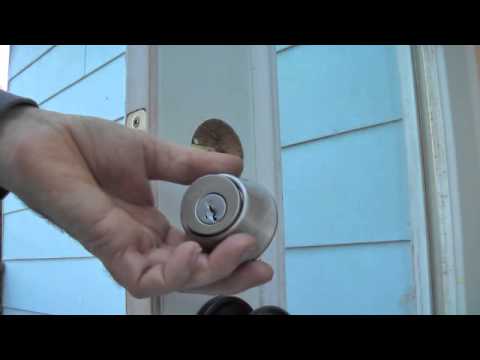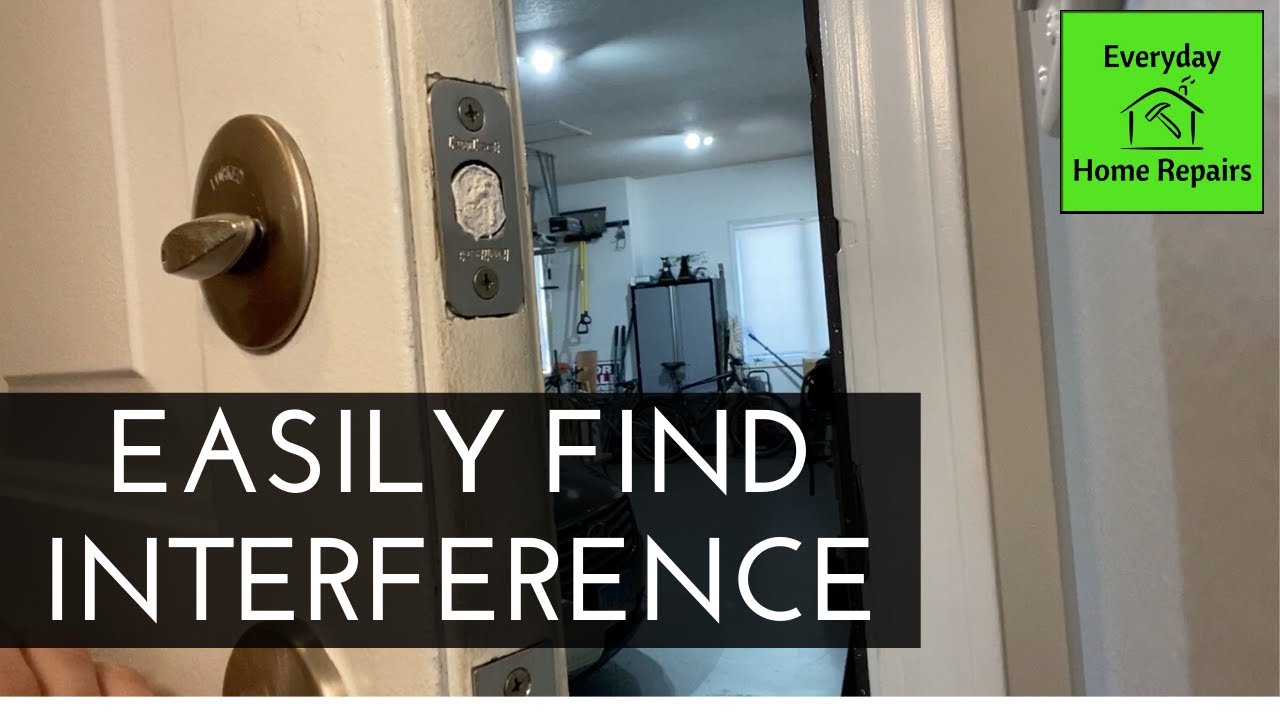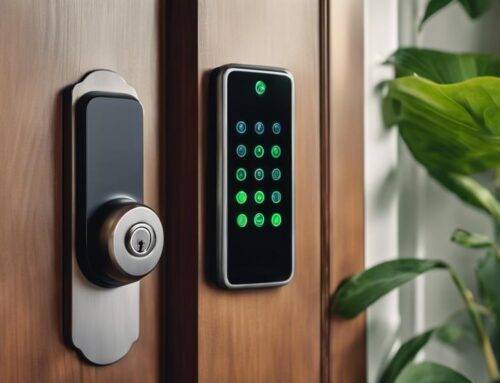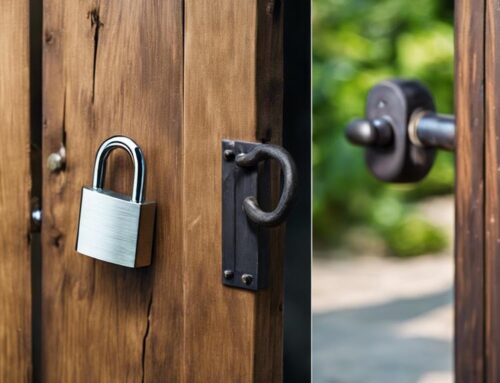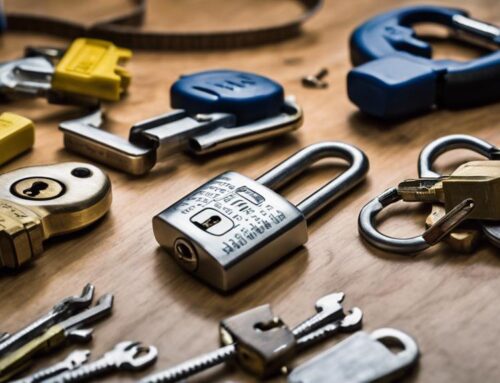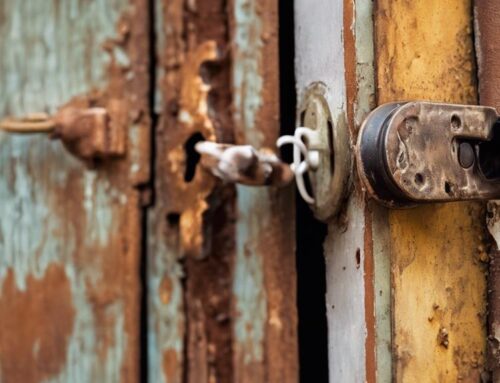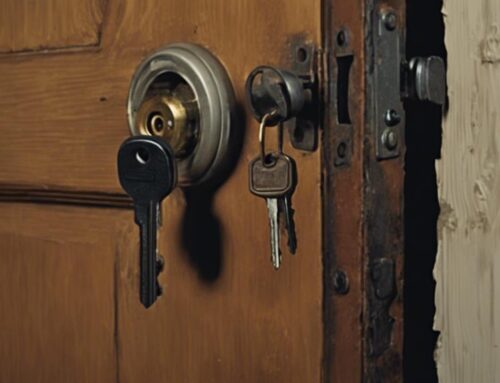Common broken lock issues include sticky locks, frozen mechanisms, and misalignment. Sticky locks often result from debris buildup and need regular lubrication. During winter, locks can freeze; use deicing spray instead of exerting pressure on the key. Misalignment from loose hinges or warped door frames requires professional adjustment. If a key breaks inside the lock, don’t apply excessive force—use needle-nose pliers or contact a locksmith. Door closure problems often stem from misaligned strike plates or latch bolts. Identifying these issues early guarantees your locks stay secure and functional. Explore more to understand how to handle these and other frequent lock problems effectively.
Key Takeaways
- Sticky locks often result from lack of lubrication or debris buildup; regular maintenance and suitable lubricants can resolve this.
- Frozen locks due to cold weather can be fixed with deicing spray or gentle warming; avoid forcing the key.
- Misalignment issues, caused by loose hinges or warped door frames, require professional adjustment and regular maintenance.
- Broken keys in locks need careful extraction with tools or professional help; avoid forcing keys to prevent breakage.
- Door closure problems, like misaligned strike plates or warped frames, can be fixed by inspecting and adjusting the door components.
Sticky Locks
Have you ever found yourself jiggling your keys before they catch the lock? If so, you’re likely dealing with sticky locks. This common issue can be both frustrating and a potential security risk. Sticky locks often result from a lack of lubrication or debris buildup within the lock mechanism. Over time, dust, dirt, and other particles can accumulate, making it difficult for the key to turn smoothly.
To address sticky locks, regular maintenance is key. Applying a suitable lubricant can help guarantee the internal components move freely. However, if the problem persists despite lubrication, it might be time to ponder more serious measures. In some cases, repair or replacement of the lock becomes necessary to prevent complete lock failure, which can leave you locked out or result in compromised security.
For severe cases where simple maintenance doesn’t resolve the issue, seeking the help of a professional locksmith is recommended. A locksmith can thoroughly clean the lock, remove any stubborn debris, and provide expert advice on whether repair or replacement is the best course of action. By taking these steps, you can assure your locks remain functional and secure.
Frozen Locks
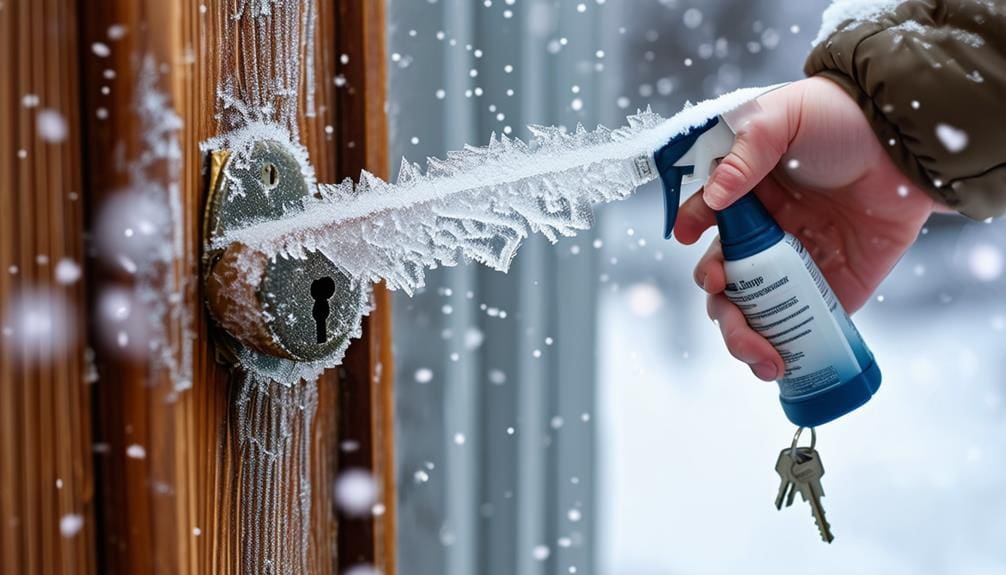
Frozen locks can be a real headache, especially when cold weather causes moisture to freeze and block your key. When you encounter a frozen lock, it’s vital not to force the key, as this can lead to damage. Instead, consider deicing strategies to guarantee the issue is resolved safely.
One effective method is to use a deicing spray, which can quickly dissolve the ice. If you don’t have a deicing spray, you might try gently warming the key with a lighter and then inserting it into the lock. However, these solutions aren’t always foolproof. In many cases, seeking the help of a professional locksmith is the safest option. They have specialized tools and techniques to deice locks without causing damage.
| Situation | Recommended Action |
|---|---|
| Key won’t insert | Use deicing spray or warm key gently |
| Lock remains frozen | Contact a professional locksmith |
| Regular occurrence | Install weather-resistant locks |
Relying on emergency locksmith services guarantees your safety and security, especially since they are available 24/7. By opting for professional deicing, you prevent further damage and maintain the lock’s proper functionality. Remember, handling frozen locks with care is crucial for long-term safety and security.
Misalignment
While frozen locks can be frustrating during winter, misalignment issues present their own set of challenges, often making it difficult to latch and secure your door properly. You might notice that your door doesn’t close completely or the lock doesn’t engage smoothly. These symptoms often indicate a misaligned door latch, which can stem from several underlying issues.
Loose hinges are a common culprit. Over time, the screws in your door hinges can loosen, causing the door to sag and misalign with the strike plate. A warped door frame is another frequent cause. Environmental factors like humidity and temperature changes can warp the frame, preventing the lock components from aligning correctly.
To fix these issues, a professional locksmith can adjust the strike plate, verifying it matches up with the misaligned door latch. They may also tighten or replace loose hinges to restore proper alignment. In some cases, the lock components themselves might need adjustment or replacement if they’re improperly installed.
Regular maintenance and inspection can help you catch these problems early. By tightening hinges and checking the strike plate periodically, you’ll secure that your door locks function smoothly and securely, preventing misalignment from causing further issues.
Broken Key in Lock
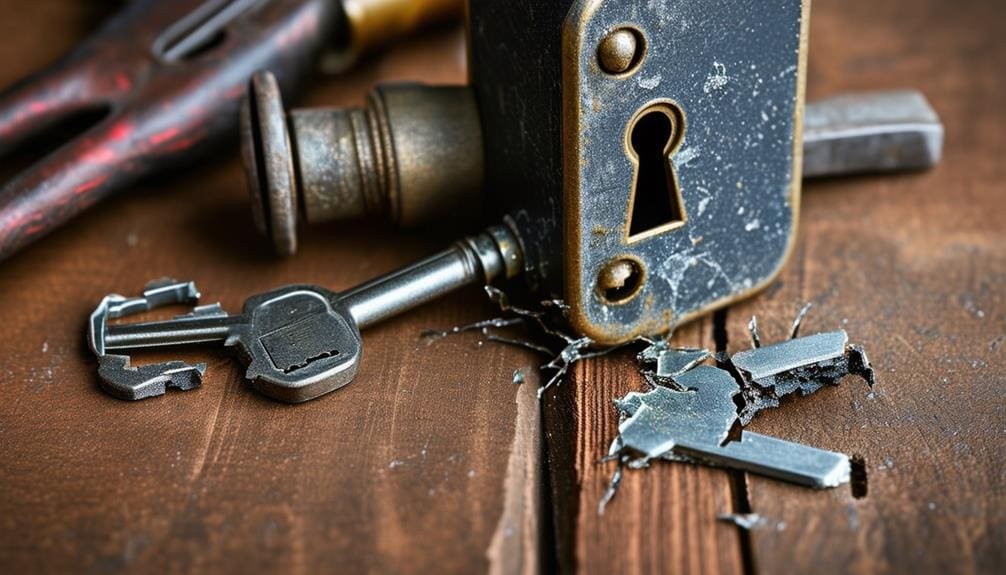
When a key breaks in a lock, don’t attempt to turn or remove it yourself, as this could cause further damage. Extracting the broken key requires precision and specialized tools, which is why you should contact a professional locksmith. They’ll efficiently remove the broken key and help you understand how to prevent future breakage.
Extracting Broken Key
To extract a broken key from a lock, use needle-nose pliers to carefully grip and remove the broken pieces. Start by confirming the lock is in the correct alignment—the same position it was in when the key broke. Gently insert the needle-nose pliers into the keyhole and try to grip the exposed part of the broken key. Be meticulous and avoid pushing the broken key further into the lock, as this can cause additional damage.
If the broken key is difficult to move, consider applying a small amount of lubricant to the keyhole. This can ease the extraction process by reducing friction. Check that the lubricant is suitable for locks to avoid any potential damage to internal mechanisms.
Should you find that the needle-nose pliers are unsuccessful, it’s wise to seek professional help. A locksmith has specialized tools and expertise to safely extract the broken key without compromising the lock’s integrity. Attempting to extract a deeply embedded key yourself can lead to more damage, ultimately making the lock unusable.
Preventing Key Breakage
Frequently, taking simple precautions can greatly reduce the likelihood of key breakage in your lock. Start by being cautious when locking and opening doors. Rushing or using excessive force can lead to key breakage. Always make sure you’re using the correct key to avoid insertion issues that can cause damage to both the key and the lock.
Regularly check your keys for cleanliness and debris. Dirt and grime can accumulate, causing friction and making it challenging to insert the key smoothly. This increases the risk of breakage. Clean your keys periodically with a mild detergent and a soft cloth to maintain their condition.
Avoid forcing the key into the lock. If you encounter resistance, there might be something obstructing the lock mechanism. Applying undue pressure can snap the key. Instead, gently wiggle the key or check for visible obstructions before proceeding.
Proper maintenance of both the lock and the key is essential. Lubricate the lock with a graphite-based lubricant to guarantee smooth operation and reduce wear and tear. Regularly inspect your keys for any signs of wear or damage, and replace them if necessary. By following these meticulous steps, you’ll effectively prevent key breakage and ensure the longevity of your locks.
Professional Locksmith Services
Relying on professional locksmith services guarantees that a broken key in your lock is expertly extracted without causing any additional harm. When you hire a professional locksmith, you’re enlisting the help of someone with the expertise to address broken keys efficiently. Locksmiths use specialized tools and techniques to remove broken keys, maintaining the integrity of your lock remains intact.
A professional locksmith’s training allows them to handle various lock types, whether residential or commercial, providing an efficient solution tailored to your specific needs. The precision and care they bring to the task prevent further issues, such as damage to the lock mechanism, which could be costly and time-consuming to repair.
Moreover, many locksmith services offer emergency assistance, so you don’t have to wait long to regain access to your locked area. This prompt service is essential, especially in urgent situations where time is of the essence. By opting for professional help, you make sure the problem is resolved quickly and effectively, minimizing inconvenience and stress.
In essence, hiring a professional locksmith for broken key issues ensures a meticulous and precise solution, restoring access and maintaining the security of your property.
Door Won’t Close
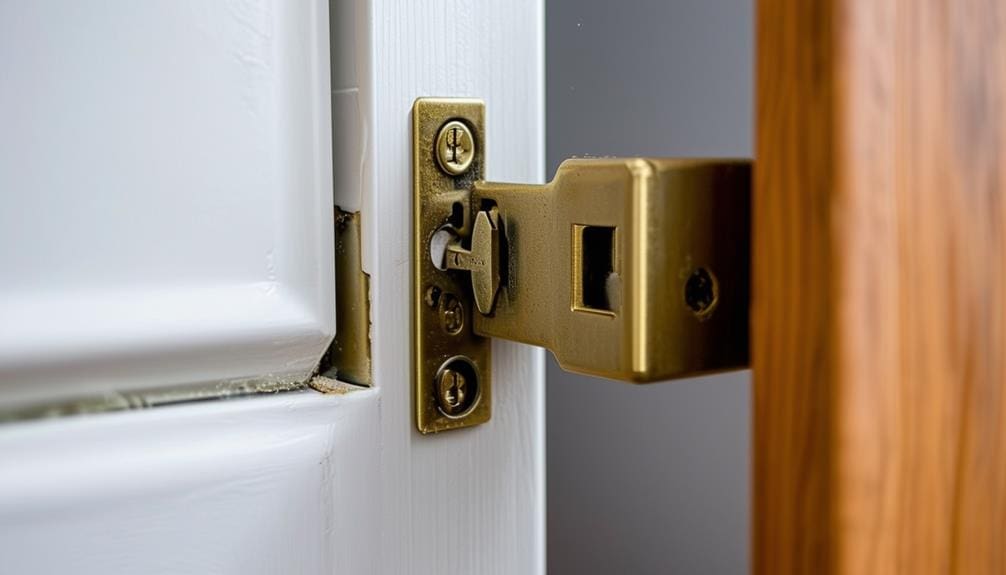
When your door won’t close, start by checking if the strike plate is misaligned, which can prevent the latch bolt from engaging properly. Inspect the door frame for any warping that could obstruct closure. Additionally, examine the latch bolt to confirm it’s functioning correctly and not sticking.
Misaligned Strike Plate
A misaligned strike plate can be an important cause of your door not closing properly, compromising both security and functionality. When the strike plate is not aligned with the latch, the door won’t latch securely, causing it to remain ajar or be difficult to lock. This misalignment can result from loose screws, worn hinges, or gradual shifting of the door frame over time.
To tackle this issue, start by inspecting the strike plate and latch alignment. If you notice any disparities, adjust the strike plate positioning. Begin by tightening any loose screws. If that doesn’t resolve the issue, you may need to shim the strike plate or slightly reposition it to guarantee the latch fits perfectly into the strike plate slot. Sometimes, realigning the door frame might be necessary if the misalignment is severe.
Consistent maintenance is vital in preventing such issues. Regularly check the screws and hinges for wear and tear, and make sure that everything remains securely fastened. By addressing these minor issues promptly, you can maintain smooth operation of your door lock and avoid more significant problems down the line. Regular inspections and timely adjustments are key to keeping your door functioning optimally.
Warped Door Frame
Due to temperature fluctuations, moisture exposure, or structural issues, a warped door frame can impede your door from closing properly and compromise the alignment of your lock. This misalignment can create significant issues with the latch and strike plate, making it challenging to secure your door effectively. When the door frame warps, even a slight shift can cause the latch to miss the strike plate, resulting in improper door closure and potentially leaving your property vulnerable.
To identify a warped door frame, examine the gaps around your door. Uneven spaces or difficulty in closing the door are telltale signs of warping. Additionally, pay attention to any sticking or resistance when attempting to lock the door, as these often indicate alignment issues.
Addressing a warped door frame involves realigning it to ensure proper door closure and lock functionality. You might need to call a professional locksmith who can assess the extent of the warping, adjust the lock mechanism, and verify that the latch and strike plate align correctly. Proper realignment will not only resolve the immediate issue but also restore the security and integrity of your door, providing you peace of mind.
Latch Bolt Issues
Encountering issues with your door not closing properly often points to problems with the latch bolt alignment. A misaligned latch bolt can prevent the door from fully engaging with the strike plate, leading to significant security concerns. Here’s a meticulous approach to diagnosing and resolving latch bolt issues:
- Inspect for Obstructions: Confirm there’s no debris blocking the latch bolt from fully extending into the strike plate. Even small obstructions can cause misalignment.
- Check the Strike Plate: If the strike plate is not properly aligned with the latch bolt, the door won’t close smoothly. You might need to adjust or reposition the strike plate to achieve proper alignment.
- Hinge Adjustment: Sometimes, the door hinges themselves may need adjustment. Tighten loose screws or slightly realign the hinges to guarantee the door sits correctly within the frame.
- Regular Maintenance: Periodically inspecting and maintaining your door can prevent latch bolt issues. Lubricate the latch bolt and verify all components are in working order to avoid future misalignments.
Broken Lock
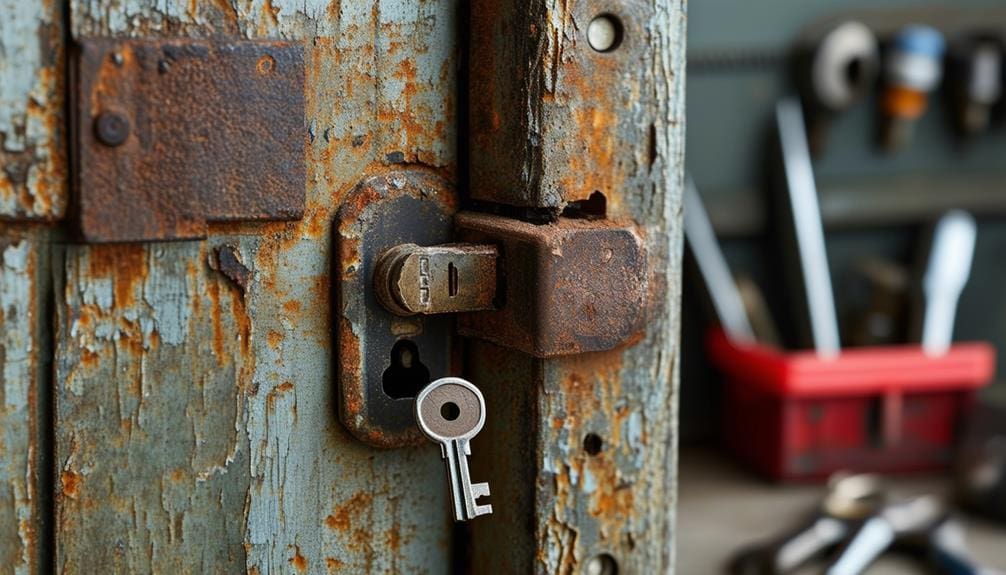
Experiencing a broken padlock often stems from internal mechanical issues or visible external damage. Whether it’s a worn-out part or rust, lock issues are a common problem that can compromise the security of your home. A faulty lock mechanism can prevent your door from securely fastening or releasing properly, posing significant risks. To fix a faulty lock, it’s vital to identify the exact problem and address it promptly.
| Common Lock Issues | Effective Solutions |
|---|---|
| Worn-Out Parts | Replace or lubricate the components |
| Rust | Clean and lubricate the padlock |
| Improper Usage | Educate on proper handling |
| Visible External Damage | Repair or replace the padlock |
| Faulty Lock Mechanism | Professional locksmith service |
Regular maintenance can prevent these issues and guarantee your lock remains operational. Check for signs of wear and tear, and lubricate the internal components periodically. If you encounter a broken padlock, don’t hesitate to call a professional locksmith. They can diagnose and fix the issue efficiently, restoring the security of your home. Remember, a well-maintained lock is fundamental to your safety and peace of mind. Securing your locks are in good condition is not just about convenience, but about safeguarding what matters most.
Key Insertion Issues
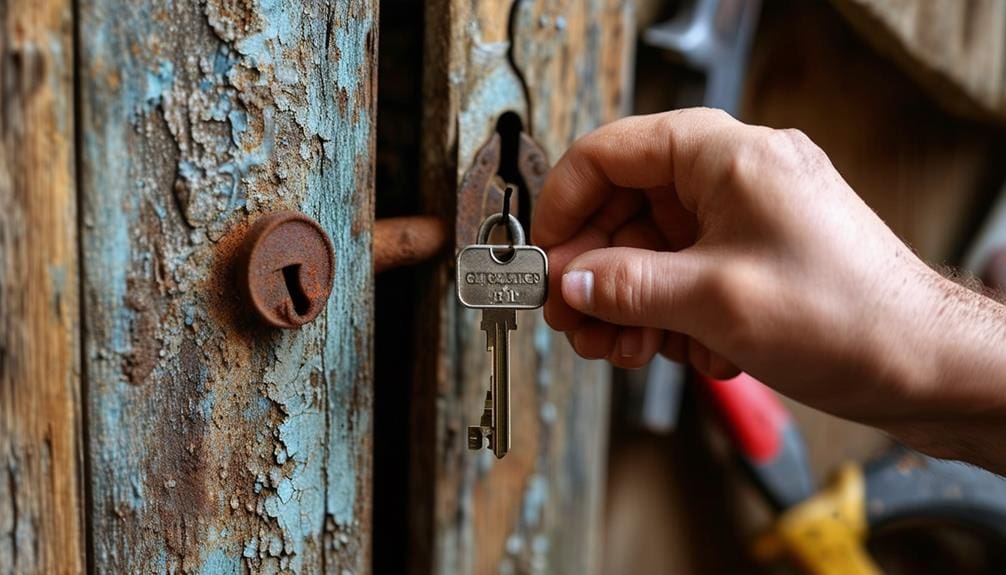
Inserting your key and feeling resistance or blockage often points to a keyway obstructed by debris like dust or lint. When you encounter key insertion issues, it’s vital to identify and address the root cause promptly. A blocked keyway can usually be cleared with simple tools and regular maintenance practices. Here’s how you can tackle this problem effectively:
- Inspect the Key and Keyway: Look for visible debris or damage. Bent, chipped, or damaged keys can also prevent smooth insertion.
- Use Compressed Air: Blow compressed air into the keyway to dislodge any dust or lint that might be causing the blockage.
- Apply a Key Cleaner: Insert a key cleaner into the keyway to remove any remaining debris. This tool is specifically designed for cleaning locks.
- Regular Maintenance: Clean and lubricate the keyway periodically to prevent future blockages. This proactive approach can save you from recurring key insertion issues.
Taking these steps guarantees that your keyway remains clear, facilitating smooth key insertion and avoiding the frustration of blocked keyways. Regular maintenance is essential in maintaining the functionality and longevity of your locks.
Jammed Locks
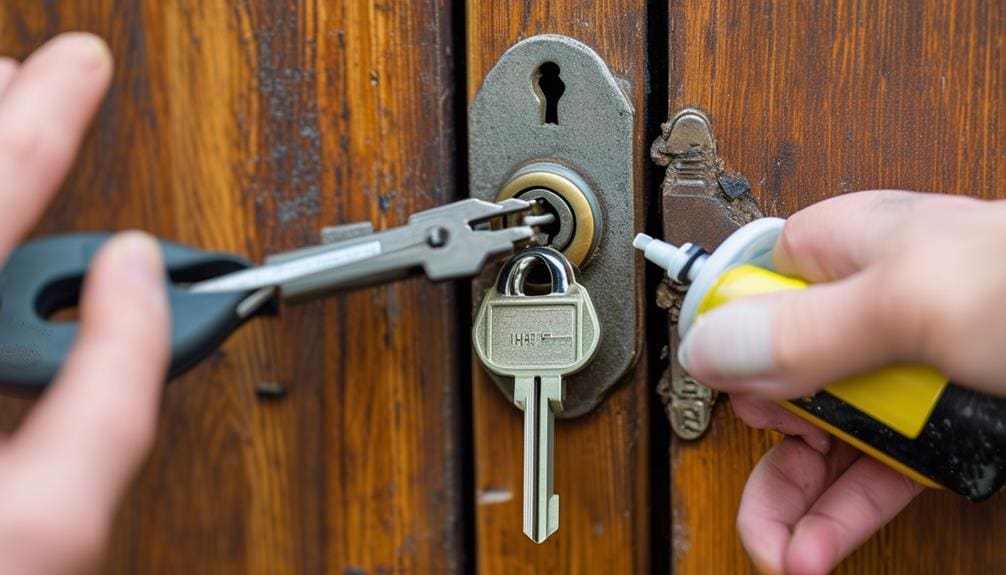
When addressing key insertion issues, it’s also important to be aware of jammed locks, a common problem often caused by dirt, debris, or rust within the lock mechanism. A jammed door can disrupt your daily routine and compromise security.
To tackle this issue, start by applying lubricant specifically designed for locks. This can help loosen the internal components. It’s vital to avoid using force, as excessive pressure can damage the lock further. Instead, gently insert and turn the key after lubrication.
Regular lock maintenance is essential to prevent jams. Cleaning your locks periodically removes dirt and debris, reducing the likelihood of rust buildup.
Here’s a quick reference table to help you manage jammed locks effectively:
| Solution | Description |
|---|---|
| Applying Lubricant | Use lock-specific lubricants to ease the mechanism. |
| Avoid Using Force | Gently work the key; don’t force it. |
| Professional Help | Contact professional locksmiths for persistent jams. |
| Regular Cleaning | Maintain locks to prevent dirt and rust buildup. |
| Inspection | Regularly inspect locks for signs of wear and tear. |
If these steps don’t resolve the issue, it’s advisable to reach out to professional locksmiths. They have the expertise and tools needed to effectively address and fix jammed locks, ensuring your security and peace of mind.
Frequently Asked Questions
How Do You Troubleshoot a Lock?
To troubleshoot a lock, check for alignment issues, try lock picking techniques, test key extraction methods, use lubrication tips like graphite, and consider cylinder replacement or the rekeying process if problems persist. Seek professional help if needed.
What Is the Most Common Locking Mechanism?
Did you know 70% of residential properties use cylinder locks? These locks, including padlock types, mortise locks, deadbolt options, and combination locks, offer versatile security solutions. Pin tumbler mechanisms are especially popular for their reliability.
What Causes Locks to Break?
You’ll find that locks break due to rust buildup, key jamming, incorrect installation, wear and tear, and foreign object obstruction. Each issue compromises the lock’s functionality, leading to failure if not addressed promptly and correctly.
How Do You Tell if a Lock Is Broken?
You can tell if a lock is broken by checking if the key’s not turning, the mechanism’s jammed, screws are loose, rust’s building up, or the springs are worn out. These signs indicate potential lock failure.
Conclusion
By identifying and addressing common lock issues like sticky locks, frozen mechanisms, and broken keys, you can keep your home as secure as a fortress. Don’t let misalignment or key insertion problems leave you standing out in the cold. With a bit of diligence and precision, you can turn these obstacles into mere bumps in the road. Remember, a well-maintained lock is the key to peace of mind and a door that always opens smoothly.

